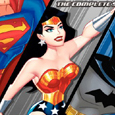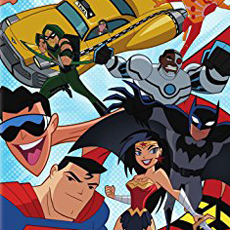Warner Bros. (November 17, 2001 – May 13, 2006), Warner Home Video (November 10, 2009), 15 discs, 2062 mins plus supplements, 1.33:1 standard (discs 1-4)/1.85:1 “matted” widescreen (discs 5-8)/1.85:1 “matted” anamorphic widescreen (discs 9-14), Dolby Digital 2.0 Stereo, Not Rated, Retail: $99.98
Storyboard:
Justice League finally gets released in a complete series set containing all 91 episodes from the show’s five year run on the Cartoon Network across 14 discs.
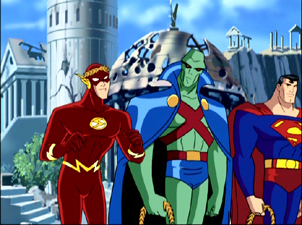
The Sweatbox Review:
The cartoons from the DC animated universe have become something of a cartoon staple for Warner Bros. over the past few decades. However, it wasn’t until Batman: The Animated Series premiered in 1992 on Fox that the full potential of these classic characters became evident. Batman became a fully well-rounded character and the animation was considered groundbreaking. After Batman came Superman whose show premiered on the now-defunct network WB network in 1996. At the beginning of this latest decade, the field of DC superhero shows expanded with Static Shock (2000-2004) and The Zeta Project (2001-2002), but perhaps the landmark cartoon of the DC animated universe of the past decade was Justice League which premiered in 2001 on the Cartoon Network to instant popular and critical acclaim.
It’s important to remember the climate surrounding television and the country at the time Justice League premiered on the Cartoon Network in November of 2001. The events of 9/11 were still fresh in people’s minds and the country was rallying around a wartime president. This mood is evident in the first episode of the show when the country rallies around a team of superheroes that band together to form the Justice League. The team was made up of classic superhero characters familiar to fans of the Superfriends franchise as well as some new additions from the Justice League comics. Gone were the child sidekicks and pets from the old days and in was a more racially and culturally sensitive cast of heroes. They included an additional female character (Hawkgirl) and an African-American Green Lantern named John Stewart. All of this helped bring the characters from the duality of the Cold War into the multi-polar world of the 21st Century.
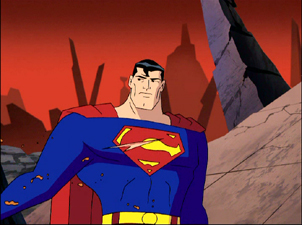
The tone and structure of the new show would also be different from previous versions. The storylines were frequently split up into multi-episode arcs as well as season-long mysteries and character development. The characters’ emotions and shortcomings are frequently on display such as Wonder Woman’s conflicts with her mother, Batman’s lack of team spirit, Superman’s trusting nature, and the Flash’s lack of seriousness. The show was also much more serious than other animated versions of these same characters and explored darker themes and characters. Frequently, the Justice League was in actual physical peril and their limitations as superheroes were explored in great depth. In the first three-part episode of the series, the main reason for their union in a Justice League is that Superman is unable to defeat an alien invasion by himself. He quickly seeks and receives help from Batman, Wonder Woman, Hawkgirl, the Green Lantern, Martian Manhunter, and the Flash. The main superheroes frequently have to contend with the consequences of their mistakes such as when Green Lantern is accused of (and confesses to) accidentally causing the destruction of an entire planet using his powers. All of these changes allowed the franchise to reach a new level of success with fans and critics alike.
The first season of the show ran from November 17th, 2001 until November 9th, 2002. Throughout the season, the writers explored different settings for their heroes. In fact, each new episode seemed to focus on a new location or parallel universe with the heroes and villains of that world. The episodes take place in outer space (more than once), Atlantis, Themyscira, Gorilla City, a parallel universe, medieval times, and back in time in an alternate WWII. With only a few exceptions, most of these episodes allow one or two Justice League members to take the spotlight in solving a mystery and saving the day. By not showcasing flashy, well-known villains in every episode, the writers were able to more fully-develop the main superheroes without resorting to a Superman vs. Lex Luthor fight every week (although that episode does exists). Speaking of villains, villains get their fair share in the spotlight with Lex Luthor even attempting to create a supervillain group called the Injustice Gang. Other prominent villains that made up the “Legion of Doom” from the original cartoon also make an appearance. For an in-depth take on the first season of the show, read Animated View’s original take on it here.
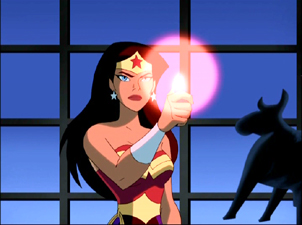
The first season of the show is made up of 10 two-part episodes and 2 three-part episodes and is divided on this set as follows:
Disc One
1. Secret Origins Part One
2. Secret Origins Part Two
3. Secret Origins Part Three
4. In Blackest Night Part One
5. In Blackest Night Part Two
6. The Enemy Below Part One
7. The Enemy Below Part Two
Disc Two
8. Injustice for All Part One
9. Injustice for All Part Two
10. Paradise Lost Part One
11. Paradise Lost Part Two
12. War World Part One
13. War World Part Two
Disc Three
14. The Brave and the Bold Part One
15. The Brave and the Bold Part Two
16. Fury Part One
17. Fury Part Two
18. Legends Part One
19. Legends Part Two
Disc Four
20. A Knight with Shadows Part One
21. A Knight with Shadows Part Two
22. Metamorphosis Part one
23. Metamorphosis Part Two
24. The Savage Time Part One
25. The Savage Time Part Two
26. The Savage Time Part Three
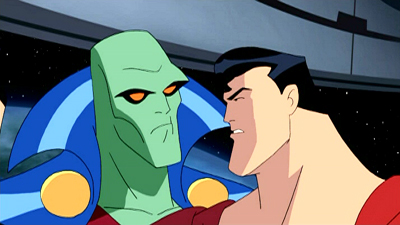
While some villains got their time in the spotlight during the first season, their time to shine really arrived in the second season of the show which ran from July 5, 2003 until May 29, 2004. The episodes in the show’s second (and perhaps its most creative) season feature villains not only as antagonists for the Justice League, but as full-fledged characters adding to the richness of the Justice League universe. In the very first episode of the season, we get the classic Superman villains Brainiac and Darkseid in the same episode. As the season progressed, each episode would tease audiences with an opening featuring a new, and sometimes popular, central villain causing havoc on Earth. Other villains prominently featured in the season include Lex Luthor, Doctor Destiny, Vandal Savage, Despero, Solomon Grundy, Gorilla Grodd, and even the Joker. The villains also team up on several occasions creating parallel teams that join together to fight against the Justice League. In Secret Society, Grodd attempts to reorganize a new version of the Injustice Gang comprised of Parasite, Giganta, Sinestro, The Shade, Clayface, and Killer Frost. Perhaps the most interesting villains appear in A Better World when alternate-universe members of the Justice League (called the Justice Lords) take over for our heroes in their reality. It was very interesting to see these memorable heroes cut loose and break their own rules of engagement. Of course, the real highlight of the season is the memorable three-part finale where Hawkgirl is revealed to be a spy for the Thanagarians. It leads to an amazing season finale that initially was written to serve as a finale for the series.
The second season of the show continued with the two-part episode format (11 in total), in addition to the first stand-alone story of the show (Comfort and Joy), and one three-part would-be series finale. The episodes are distributed over four discs as follows:
Disc Five
1. Twilight Part One
2. Twilight Part Two
3. Tabula Rasa Part One
4. Tabula Rasa Part Two
5. Only a Dream Part One
6. Only a Dream Part Two
Disc Six
7. Maid of Honor Part One
8. Maid of Honor Part Two
9. Hearts and Minds Part One
10. Hearts and Minds Part Two
11. A Better World Part One
12. A Better World Part Two
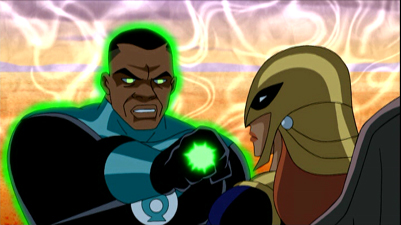
Disc Seven
13. Eclipsed Part One
14. Eclipsed Part Two
15. The Terror Beyond Part One
16. The Terror Beyond Part Two
17. Hereafter Part One
18. Hereafter Part Two
Disc Eight
19. Secret Society Part One
20. Secret Society Part Two
21. Comfort and Joy
22. Wild Card Part One
23. Wild Card Part Two
24. Starcrossed Part One
25. Starcrossed Part Two
26. Starcrossed Part Three
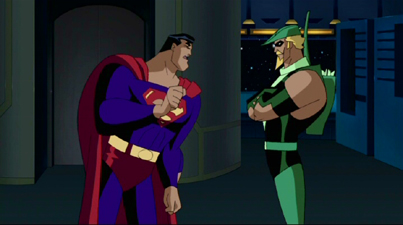
If the second season of the show largely highlighted the villains on the show, the first season of Justice League Unlimited (or the third of Justice League) was all about the heroes. In this case, it was all about the new superheroes. With an expanded roster of over 50 new heroes joining the Justice League, each episode would normally deal with just a couple of new characters matched up with veteran Justice League members. One notable addition to the Justice League roster is Green Arrow, a popular member of the Justice League in many different comic book versions. Having given their writers free-range on writing for their favorite characters, many episodes focus solely on one character such as The Greatest Story Never Told which focuses almost exclusively on Booster Gold. Of course, the veteran Justice League members also get their own stories, giving them a time to shine. In For the Man Who Has Everything, we get deep inside Superman’s psyche when he is captured by the villain Mongul and he dreams of an idyllic life he never had back on Krypton. Some of the most interesting episodes continue to rely on the established dynamics of the core characters of Wonder Woman, Batman, Flash, Superman, and Green Lantern. A fun episode that includes many of these characters is Kid Stuff when child versions of each character battle against Mordred who has gotten rid of all adults on the Earth. The one core character that is sorely missing from the season is Martian Manhunter who serves as a sort of dispatcher from his post at the Watchtower. It also takes a few episodes before we get Hawkgirl returning to the Justice League after she defeats Solomon Grundy in the episode Wake the Dead. While the episodes were mostly stand-alone episodes, a storyline featuring a shadow government agency and Project Cadmus is prominently featured in the latter half of the season. This storyline explores what governments would actually do if there were superheroes out there that could potentially destroy their planet. Perhaps the most memorable episode of this season is the season finale, Epilogue, which takes place in the future of Batman Beyond, wrapping up the Project Cadmus storyline and is meant to serve as a series finale for the show.
When Justice League was renewed as Justice League Unlimited, the network asked producers to change the format of the show to contain more stand-alone episodes. The producers then created 24 stand-alone episodes and introduced some season-long storylines as well as one official two-part episode. The 26 episodes are divided on four discs as follows:
Disc Nine
1. Initiation
2. For the Man Who Has Everything
3. Hawk and Dove
4. Fearful Symmetry
5. Kids’ Stuff
6. This Little Piggy
7. The Return
Disc Ten
8. The Greatest Story Never Told
9. Ultimatum
10. Dark Heart
11. Wake the Dead
12. The Once and Future Thing Part One
13. The Once and Future Thing Part Two
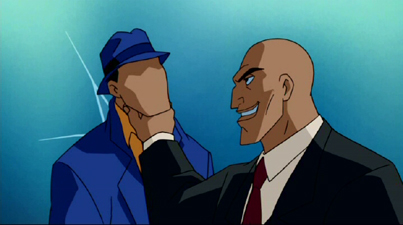
Disc Eleven
14. The Cat and the Canary
15. The Ties That Bind (AKA Miracles Happen)
16. The Doomsday Sanction
17. Task Force X
18. The Balance
19. Double Date
20. Clash
Disc Twelve
21. Hunter’s Moon (AKA Mystery in Space)
22. Question Authority
23. Flashpoint
24. Panic in the Sky
25. Divided We Fall
26. Epilogue
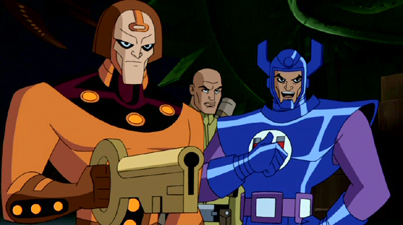
Of course, Epilogue did not become the show’s series finale and Justice League Unlimited was renewed by the Cartoon Network for an additional (shortened) season. In this last season, the league must deal with a reorganized Secret Society led by Gorilla Grodd who has recruited Lex Luthor to create an ultimate group of villains. After playing around with new heroes in the previous season, this season brings the core members of the Justice League back to the spotlight, along with a few select new heroes (notably Supergirl and Green Arrow). There is a great two-part storyline featuring Hawkman and Hawkgril (Shadow of the Hawk and Ancient History) that deals with the issue of destiny and the future of the relationship between Green Lantern and Hawkgirl. The Secret Society storyline is slowly introduced throughout the season, leading to a clash of egos between Luthor and Grodd for supremacy. When the Secret Society inadvertently resurrects Darkseid who wants to destroy the Earth, the Society turns to the Justice League for help, leading to the season and series finale that culminates in a huge battle in Metropolis. For an in-depth take on the last season of the show, read Animated View’s original take on it here.
The shortened final season of Justice League was made up of only 13 episodes, all of which were stand-alone episodes (although some episodes flowed into one another). The episodes are divided up as follows:
Disc Thirteen
1. I Am Legion
2. Shadow of the Hawk
3. Chaos at the Earth’s Core
4. To Another Shore
5. Flash and Substance
6. Dead Reckoning
7. Patriot Act

Disc Fourteen
8. The Great Brain Robbery
9. Grudge Match
10. Far from Home
11. Ancient History
12. Alive!
13. Destroyer
Is This Thing Loaded?
The special features on this set are direct transplants from the individual season sets, with the addition of an extra bonus disc containing a brand new featurette called Unlimited Reserve: Exploring the Depths of the DC Universe. While there are multiple audio commentaries and music-only audio tracks spread out over the 12 discs, there are also some very interesting and entertaining featurettes, sometimes multiple ones for each season.
On Disc Two, we find our first featurette called Inside Justice League (9:12). In this featurette, the host, Jason Hillhouse, holds a discussion with the producers of the show – James Tucker, Rich Fogel, Bruce Timm, and Dan Riba. They talk about their initial hesitation in creating the show after the successes of Batman:TAS, Superman:TAS, and Batman Beyond. Their initial hesitation was regarding the task of animating bigger action pieces (the technology wasn’t always there). They were also worried about the apparent lack of powerful villains to fill stories out every week. Eventually, they get to talking about their initial ideas and how they wrestled in finding someone for the 7th spot on the team. Apparently, they were between Atom Man, Hawkman, and Aquaman, but in the end went with Hawkgirl. They also explain that they stayed away from showing any supporting characters from the mythos of the characters, instead focusing on the main characters. They then go into detail on their versions of each character and on their favorite stories from the show’s first season. One interesting thing I noticed from this discussion is how the creators took some of their mistakes from this season and applied it to make the second season much stronger, particularly in relation to Superman’s character and in the style of the show.
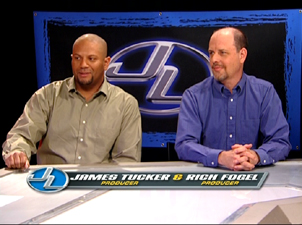
Also, on Disc Two is a featurette called Storyboards: The Blueprint for Justice (7:10). In this short featurette, the creators and animators talk about storyboarding the show with timing, movement, and camera directions. In the frames of storyboard, we can clearly see that the show was matted in full screen but meant to be shown in widescreen with more dynamic action sequences. The creators then explain how the director breaks down the scene between different animators and how many drawings there usually are for every act. Finally, they explain the importance of having the vocal tracks available to animate the sequences.
The final featurette on Disc Two is The Look of the League (4:18). Here, the creators talk about designing the characters and giving them iconic looks that will last for decades. They go into detail on the costume changes for Batman, Green Lantern, Superman, Hawkgirl, Flash, Martian Manhunter, and Wonder Woman. It’s an interesting take on the characters and explains why they made the subtle changes that they made when the show first premiered.
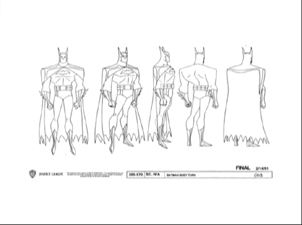
On Disc Four, Jason Hillhouse hosts another panel called Justice League: The First Mission (5:54). Here, he lets the creators James Tucker and Bruce Timm explain what they were thinking when they created the original promo for the show. When they pitched the idea, they used footage from old series, using models from Batman Beyond and stock characters from other old shows. They explain that they had initially created this promo for the Kids WB version of the show and that they included many young characters like Robin, Impulse (instead of Flash), and a young female Cyborg. The promo itself, which they show in its entirety here, was never actually used, but it gives a sense of what the show could have become if the series had gone to the Kids WB instead of the Cartoon Network.
Finally, on Disc Four, there are trailers for DC Comics Kids releases, Justice League/Batman Beyond: Season One, Ed, Edd, and Eddy: Season Two, and Hot Wheels AcceleRacers: Breaking Point.
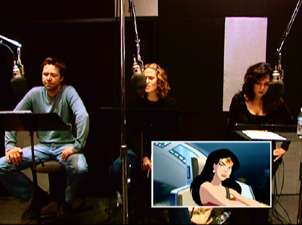
Disc Five of the show (Disc One of Season Two) contains two featurettes. The first one, Voices of Justice (10:37) features Phil LaMarr (the voice of Green Lantern) leading a conversation with the rest of the Justice League voice cast and crew – Jennifer Hale (Giganta/Killer Frost), George Newburn (Superman), Maria Canals (Hawkgirl), Susan Isenberg (Wonder Woman), and Andrea Romano (casting and voice director). They talk about their love for voice acting and how much fun they have. They then go into a discussion into the difficulties of voice acting and how posture and body language help them get into character. Finally, they talk a little bit about the energy they get from the different guest stars (Mark Hammil, Michael Ironside, Keith David, Brad Garrett) that appeared on the show’s first and second seasons. They seem like a great cast that gets along with one another and are genuinely excited about being a part of a landmark in pop culture.
The second featurette on Disc Five is Look, Up in the Sky! – The Amazing Story of Superman: Excerpt from the Documentary Produced by Bryan Singer and Kevin Burns (6:29). In this short excerpt from the impressive documentary, we basically get a brief history of Superman from comics to screen. Bryan Singer talks about George Reeve’s Superman television show, Richard Donner’s film with Christopher Reeve, Dean Cain in Lois & Clark, Smallville’s Tom Welling, and Superman Returns’ Brandon Routh. We see the different portrayals of Superman and the different approaches that the movies and series took on the character and that universe. They talk about the limited budgets they had to work with at different times. In the end, this serves as more of a promo for the Superman Returns movie, but it is an interesting excerpt from Kevin Burns’ very interesting documentary.
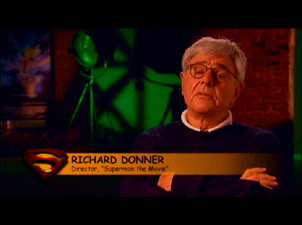
There are also multiple trailers on the disc, including one for Superman: Brainiac Attacks which shows when the disc is first popped in the player. In the trailers section, there are also previews for Superman film and television properties available on DVD (which includes a full trailer for Superman Returns), Justice League Season 2/Superman Vol. 3, Superman EA Game, the Sound of Superman CD, and February DC Comics Kids DVDs.
Skipping to Disc Seven (Disc Three of Season Two), we have Justice League Declassified (8:02). Once again, we have Jason Hillhouse discussing Season Two of Justice League with Butch Lukic, Dwayne McDuffie, James Tucker, and Bruce Tim. They talk about what they learned from the first season and how they had to juggle the different characters. They tried to learn how to get Superman out of the way since he was nearly always invincible. Some of the main things they learned to do in the second season was how to split up the action between the different characters and how to have more fun with the characters. They specifically mention the episode Twilight as an episode that opened them up to new directions. Hillhouse also highlights the styles and backgrounds of the show. They came up with more futuristic and stylistic backgrounds with brighter colors that would pop out.

The next featurette is on Disc Nine (Disc One of Season Three) called And Justice for All (9:10). Here, Bruce Timm, Wayne McDuffie, and Stan Berkowitz discuss the end of season two and how they decided to continue the storylines. They decided on the larger satellite, more troops, and having J’ohn Jones being a kind of desk sergeant at a police station coordinating the missions. They wanted to add every hero from the DC universe that they were allowed to by DC Comics. They made a laundry list of characters for DC to approve and only rarely did they get rejected. Fans initially wanted to see Green Arrow the most, but writers also wanted to add the Question, among other characters. In fact, they discuss how every writer had a favorite hero and that they sometimes took very odd choices. Finally, they discuss how they selected the voice stars for their new characters including Jeffrey Combs, Dakota Fanning, Jason Harvey, Fred Savage, Robert Picardo, Oded Fehr, and John C. McGinley.
Finally, Disc Twelve (Disc Four of Season Three) includes a special featurette focusing on the musical tracks found on the show. This is called Themes of Justice and one is allowed to listen to some of the creator’s favorite musical themes from select episode segments. They are divided as follows: “Battling Brimstone” from Initiation (2:30), “Luthor’s Stronghold” from The Return (1:39), “Let’s Go to Work” from Dark Heart (2:34), “Grundy’s Fate” from Wake the Dead (2:33), and “To the Beginning of Time” from The Once and Future Thing, Part Two: Time, Warped (1:25).
Disc twelve also holds a trailer for Superman cartoons and films available on DVD which plays when the DVD starts. The trailers section also includes previews for Teen Titans: Trouble in Tokyo, September DC Comics Kids DVDs, Justice League Heroes video game, Justice League Unlimited: Season One, Superman: Brainiac Attacks movie, and Thundercats Season Two, Vol. 2.
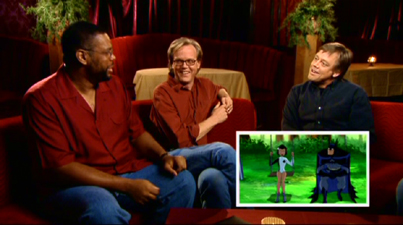
Disc Thirteen (Disc One of Season Four), includes the longest featurette on the set – Cadmus: Exposed (23:22). In it, Mark Hamill hosts a conversation with Bruce Timm, Dwayne McDuffie, and James Tucker about the eight-episode Cadmus storyline that is actually from Season Three. They comment on how they wanted the episodes to stand on their own, but have a sort of continuity to connect the show together. They say they adapted it from the comics and made it more of a shadow government agency. They decided to take all government conspiracies back from the Batman and Superman (in addition to Batman Beyond) connect to Cadmus. They explain that while in the first few episodes they are somewhat evil, when Batman confronts Amanda, we understand the grey area and what they really stand for. CCH Pounder brings the character to life and we both hate and are impressed by her at different times. They were conscious of making sure that Cadmus won at least once against the Justice League (in the episode Task Force X). They talk about how they teased the audience about Brainiac and Luthor’s relationship throughout the season. Finally, they talk about how they initially thought about having Batman team up with Cadmus, but that it would be a betrayal. With the finale, Epilogue, the writers decided to wrap some things up from previous seasons and they filled it with in-jokes and references to other shows they had created.
Disc Fourteen (Disc Two of Season Four) opens up with a trailer for Justice League Unlimited: Season Two and Batman Beyond: Season Three. The disc also includes a featurette called Justice League Chronicles where the producers, writers, and directors of the show discuss their favorite moments in the season’s final episodes.

For The Great Brain Robbery (9:40), Matt Wayne, Bruce Timm, James Tucker, and Dwayne McDuffie talk about actually making a storyline for the Legion of Doom be the center of the final season. In the end, the season became more about the Legion of Doom instead of about the heroes. We then see the creators watching the episode and making comments on what they came up with. They talk about Flash’s powers and what Lex Luthor was able to do with them on the episode.
The second episode they look at is Ancient History (13:31). After Starcrossed, they always wanted to revisit Hawkman which they could not use in Starcrossed because he could not be an evil character. In the comics, Hawkman reincarnates in different lives so they wanted to play with that angle. They had prepared the storyline to explain who the Shadow Thief was and they wanted to play with Vixen’s relationship with Green Lantern. They really enjoyed the ending of the show as far as Green Lantern’s relationship with Hawkgirl. We also get to see some of the storyboards on the corner of the screen as the episode’s second act plays on the screen.
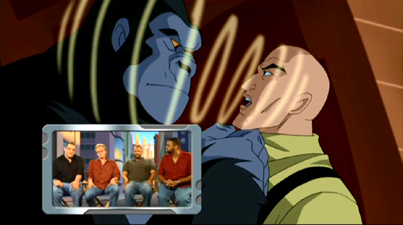
The final episode they look at is Alive! (10:30). Here, they wanted to do more of a good guy versus bad guy stories and get to some more locations in the DC Universe beyond Gotham and Metropolis. In Alive!, we get to see a story just with villains fighting one another. This was done to kind of wrap up the Legion of Doom storyline. They liked having half of the villains taking out the other half of the villains. Once again, we get to see some of the storyboards from the battle sequence. The writers talk about dividing the villains into two different sides and how it was difficult to keep track of their allegiances.
The trailers section also includes previews for Teenage Mutant Ninja Turtles, The Batman: Season Three, and Teen Titans: Season Three.
In addition to the featurettes, there are also multiple episode commentaries on the set. There are commentaries for Season One on The Enemy Below Part Two, Legends Part Two, and The Savage Time Part Two, all with Bruce Timm, James Tucker, Glen Murakami, Rich Fogel, and Dan Riba. There are commentaries on Season Two for Twilight Part Two (with Bruce Timm, James Tucker, Butch Lukic, and Dwayne McDuffie), A Better World Part Two (with Bruce Timm, James Tucker, Stan Berkowitz, and Dwayne McDuffie), and on Starcrossed Part Three (with Bruce Timm, James Tucker, Butch Lukic, and Dwayne McDuffie). Finally, there are also commentaries on Season Three for This Little Piggy (with Bruce Timm, Paul Dini, Dwayne McDuffie, and James Tucker), and The Return (with Bruce Timm, Joaquim dos Santos, Dwayne McDuffie, and James Tucker).
There are no commentaries on season four, but there is a music-only audio track for the Final Episode of the series – Destroyer. This comes complete with an introduction by Bruce Timm explaining why there is a score for the whole episode and why they wanted to present it here on the DVD.

The only new content on this set is a bonus Disc Fifteen which contains an all-new featurette called Unlimited Reserve: A League for the Ages (16:48). In it, we get Rich Fogel, Dwayne McDuffie, Charles Hatfield (an academic), Dan Riba, Stan Berkowitz, Glen Murakami, Bruce Timm, James Tucker, Paul Dini, and Matt Wayne talking about the Superfriends universe and the development of the show over the four seasons. They discuss the old Filmation and Hanna-Barbera shows and how it was basically a boy’s club where the villains didn’t even have a chance. For their series, they wanted characters who had conflict and who had to learn to deal with each other and had to work as a team. They explain that with Justice League Unlimited, they were able to get deeper into the characters even though they had only half hour episodes. The storylines they are most proud of are the Cadmus storyline from season three, as well as the episode For the Man Who Has Everything. Having the new characters show up in the final two seasons was a way to develop some old characters (like Supergirl) and a way to basically create pilot shows for new potential series. Overall, it’s an interesting featurette, although a bit lacking in content since many of the comments here are found on the other featurettes.
Finally, the bonus disc includes trailers for Green Lantern: First Flight and Superman/Batman: Public Enemies which plays when the disc is inserted. Once inside, there are also trailers for Ben 10: Alien Force – Volume 4, Ralph Bakshi’s Lord of the Rings, two trailers for Star Wars: The Clone Wars DVDs, Batman: Brave and the Bold, and Bakugan: Heroes Rise – Volume 4.
Case Study:
Warner Bros. has compiled the full series together in a special tin case, containing two one-inch thick DVD cases. The tin case is a box with an open side where the two DVD cases slide in. The seasons are divided as Volume One (8 Discs) comprising of the first two seasons of Justice League, and Volume Two (7 Discs) made up of the Justice League Unlimited episodes as well as the new bonus disc. Volume One features Superman, Wonder Woman, and Batman on the cover with Martian Manhunter, Hawkgirl, Green Lantern, and Flash on the back. Inside the case are four double-sided DVD flaps. Volume Two features Aquaman, Doctor Fate, and Red Tornado on the cover with Green Arrow, The Atom, Green Lantern, and Martian Manhunter on the back. Inside the case are three double-sided DVD flaps with space on the case for a bonus disc. Each case contains a fourteen page disc guide detailing the division of the episodes and special features. The discs contained in this set are the same as the original individual season sets released and contain the same disc art. The bonus disc features an image of the original seven members of the Justice League raising their fists into the air.

I do not know if this was a one-time mistake, but when we received our copy of this set for review, the cover and DVD guides for the two volumes were switched around. It was a quick fix to just swap them, but it was a strange mistake to see.
Ink And Paint:
Ever since season one of Justice League was released on DVD for the first time, there have been controversies over the aspect ratio on the show. The first season was released on DVD in a standard 4:3 aspect ratio, which was the way the show was animated, although producers broadcast the show in both 4:3 and 1.85:1 at different timeslots. The producers of the show have stated on numerous occasions that they preferred the widescreen versions of the show so many fans were surprised when the first season of the show was initially released in a 4:3 ratio. When the second season of the show was released, fans got another surprise when it was released in non-anamorphic widescreen. This was eventually fixed for the third and fourth seasons (first and second seasons of Justice League Unlimited), although they were labeled as “matted” widescreen presentations. This is despite the fact that the show was always intended to be animated and released in a widescreen aspect ratio. The only reason the first season was presented with a 4:3 ratio was due to insistence by the network who in 2001 believed some viewers would not want the show to be broadcast in widescreen. At least there is no picture lost in the DVD release.

It has now been 8 years so I am a little surprised that these little issues have not been resolved. I do not particularly mind having the show in the 4:3 ratio for the first season, but not having anamorphic widescreen for the second season is a shame. I can always zoom in with my player, but it makes for a very inconsistent DVD set. I have also always bemoaned the lack of chapter stops for the episodes, at least after the opening segment. The show features some beautiful animation and complex storyboarding. The animators shot the show as if it were a live-action adventure, complete with blurred foregrounds and backgrounds in some scenes. Overall, the quality of the print is very good with few blemishes and fragments featured on the print.
Scratch Tracks:
Justice League and Justice League Unlimited have always featured an excellent Dolby Digital 2.0 track. The show sounds great in stereo and the 2.0 track is very effective. One thing that has been inconsistent over the years is the language options available on the DVDs. Seasons one and two of the show featured only one English 2.0 track along with French and Spanish subtitles. When Justice League Unlimited: Season One was released, there were English, French, and Spanish Dolby Digital 2.0 tracks with no subtitles. Finally, for its final season, the show was released with both English and Portuguese Dolby Digital 2.0 tracks, along with Portuguese subtitles. The only thing that was consistent through all this time is that the show was never released with English subtitles (Season three had no subtitles at all).
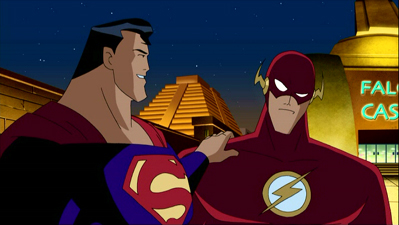
Final Cut:
Justice League is a landmark superhero show that will go down the ages as a standard for which all superhero team shows will be compared to. In my opinion, there have been better superhero shows (I still contend that Batman: TAS continues to be the pinnacle of the genre), but this is definitely one of the very best. As the show found its unique voice in the second and third seasons, it became engaging and groundbreaking in terms of stories and visual styles. With Starcrossed, the writers and producers demonstrated that they were brave enough to take a beloved character and basically add a new unexpected dimension. The same can be said for the season three ender Epilogue which added many rich details to the Batman, storyline. It will probably be another decade before we get another Justice League show and it will be a very difficult show to top. For now, the future of the franchise seems to be in the DTV movies that the Warner Premiere label has been releasing. However, we have also seen some of the humor and adventure in the current Batman: the Brave and the Bold show on the Cartoon Network. None of them will replace this show’s place and stature in pop culture, but they will inevitably learn and build upon the successes created on this show.
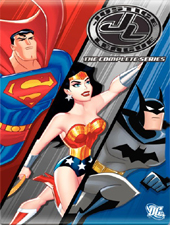 | ||
 |


